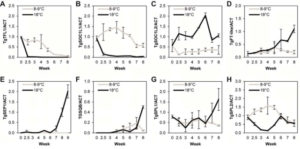Regulation of tulip flowering by temperature ($)
 Cultivation of Tulipa gesneriana (tulip), an economically important species due to its ornamental value, can be affected by warming winters, leading to low quality flowers produced out of season. Leeggangers et al. have sequenced RNA and used top-down and bottom-up approaches in tulips grown in two contrasting environments (cool and warm temperatures) to shed light on the molecular network underlying flowering induction and to study how temperature could affect such a network. With both approaches, the authors have identified several temperature-responsive genes that could be regulating the timing of the transition between vegetative and reproductive growth, some of them similar to known components of the Arabidopsis flowering pathway. The expression of some of these genes differs in cultivars with different temperature susceptibilities and correlates with phase transition, providing important information to develop tools for cultivar improvement and climate change adaptation. (Summary by Gaby Auge) Plant Physiol. doi:10.1104/pp.16.01758
Cultivation of Tulipa gesneriana (tulip), an economically important species due to its ornamental value, can be affected by warming winters, leading to low quality flowers produced out of season. Leeggangers et al. have sequenced RNA and used top-down and bottom-up approaches in tulips grown in two contrasting environments (cool and warm temperatures) to shed light on the molecular network underlying flowering induction and to study how temperature could affect such a network. With both approaches, the authors have identified several temperature-responsive genes that could be regulating the timing of the transition between vegetative and reproductive growth, some of them similar to known components of the Arabidopsis flowering pathway. The expression of some of these genes differs in cultivars with different temperature susceptibilities and correlates with phase transition, providing important information to develop tools for cultivar improvement and climate change adaptation. (Summary by Gaby Auge) Plant Physiol. doi:10.1104/pp.16.01758










Leave a Reply
Want to join the discussion?Feel free to contribute!